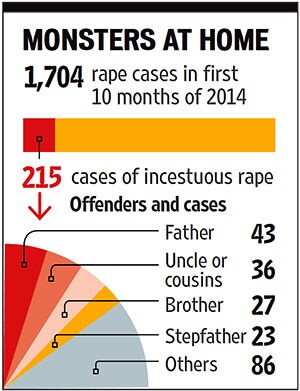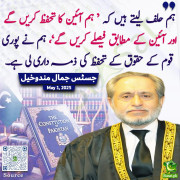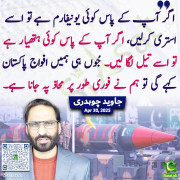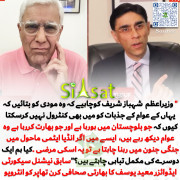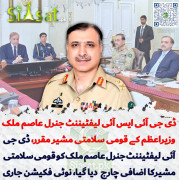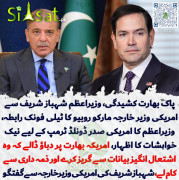ballumsingh
Banned
[TABLE="width: 770"]
[TR]
[TD]

[TABLE="width: 100%"]
[TR]
[TD][TABLE="width: 100%"]
[TR]
[TD="bgcolor: #800000"][/TD]
[/TR]
[/TABLE]
[/TD]
[/TR]
[/TABLE]
[TABLE="width: 100%, align: center"]
[TR]
[TD="align: left"][/TD]
[TD="align: right"]
[/TR]
[/TABLE]
[TR]
[TD] [/TD]
[/TD]
[/TR]
[TR]
[TD="colspan: 3"]Teenager accused of making derogatory remarks against Holy Prophet (PBUH).
[/TD]
[/TR]
[/TABLE]
LAHORE: Blasphemy allegations continue to haunt minorities in Pakistan.
Aalmi Majlis Tahafuz Khatm-e-Nabuwat (AMTKN) activists alleged that 16-year-old Sajeel committed blasphemy by making derogatory remarks against the Holy Prophet (PBUH) and his father, Rana Hakim Jameel, had done the same by portraying Sajeel as a Muslim in his school admission form.
Denying that he ever put down Islam as Sajeel’s religion and all other allegations levelled against his son, Jameel’s was a different tale.
According to him, the allegations stemmed from a school fight.
The school principal overheard some students abusing Sajeel and beat them up. The students later accused Sajeel of telling on them and beat him up. When Sajeel actually went to the principal to complain, he learnt that the students had “made up a story, telling the principal they had attacked him because he had made blasphemous remarks”.
Later, Haji Aslam, the school principal, expelled Sajeel.
Fearing their safety, the two have been on the run ever since the charges emerged.
While the police have yet to register an FIR against the accused, they have already started conducting raids for their arrests.
A member of the accused family, Rana Asfandyar, 18, was arrested by the police, who allegedly pressurised the young student to reveal his brother’s whereabouts, Asfandyar’s older brother, Rana Mujahid told The Express Tribune.
At local mosques, various religious scholars were fuelling a hate campaign against Ahmadis, Mujahid alleged, adding that evoking such hatred among the public could prove dire for his family.
However, Khushab police station SHO Raja Arshad told The Express Tribunethat since the family refused to tell them about Sajeel’s whereabouts, the police had brought Asfandyar in to record his statement at the DPO’s office. Arshad denied that they had detained the boy.
Mujahid alleged that religious scholars Qari Saeed and Waqas Ahmed were producing “false witnesses” before the police.
SHO Arshad said that they were still in the process of recording the statements of witnesses, and hence, were unable to conclude their investigations.
Meanwhile, Jameel alleged that a property dispute could also be a reason behind the accusations.
Published in The Express Tribune, December 15th, 2011.
[/TD]
[/TR]
[/TABLE]
[TR]
[TD]

[TABLE="width: 100%"]
[TR]
[TD][TABLE="width: 100%"]
[TR]
[TD="bgcolor: #800000"]
Blasphemy charges: Out of fear, Ahmadi family on the run
[/TR]
[/TABLE]
[/TD]
[/TR]
[/TABLE]
[TABLE="width: 100%, align: center"]
[TR]
[TD="align: left"][/TD]
[TD="align: right"]
Pakistan
Punjab
Punjab
[/TD][/TR]
[/TABLE]
Blasphemy charges: Out of fear, Ahmadi family on the run
By Rana Tanveer
Published: December 15, 2011
Published: December 15, 2011
[TABLE="align: center"][TR]
[TD]
 [/TD]
[/TD][/TR]
[TR]
[TD="colspan: 3"]Teenager accused of making derogatory remarks against Holy Prophet (PBUH).
[/TD]
[/TR]
[/TABLE]
LAHORE: Blasphemy allegations continue to haunt minorities in Pakistan.
Aalmi Majlis Tahafuz Khatm-e-Nabuwat (AMTKN) activists alleged that 16-year-old Sajeel committed blasphemy by making derogatory remarks against the Holy Prophet (PBUH) and his father, Rana Hakim Jameel, had done the same by portraying Sajeel as a Muslim in his school admission form.
Denying that he ever put down Islam as Sajeel’s religion and all other allegations levelled against his son, Jameel’s was a different tale.
According to him, the allegations stemmed from a school fight.
The school principal overheard some students abusing Sajeel and beat them up. The students later accused Sajeel of telling on them and beat him up. When Sajeel actually went to the principal to complain, he learnt that the students had “made up a story, telling the principal they had attacked him because he had made blasphemous remarks”.
Later, Haji Aslam, the school principal, expelled Sajeel.
Fearing their safety, the two have been on the run ever since the charges emerged.
While the police have yet to register an FIR against the accused, they have already started conducting raids for their arrests.
A member of the accused family, Rana Asfandyar, 18, was arrested by the police, who allegedly pressurised the young student to reveal his brother’s whereabouts, Asfandyar’s older brother, Rana Mujahid told The Express Tribune.
At local mosques, various religious scholars were fuelling a hate campaign against Ahmadis, Mujahid alleged, adding that evoking such hatred among the public could prove dire for his family.
However, Khushab police station SHO Raja Arshad told The Express Tribunethat since the family refused to tell them about Sajeel’s whereabouts, the police had brought Asfandyar in to record his statement at the DPO’s office. Arshad denied that they had detained the boy.
Mujahid alleged that religious scholars Qari Saeed and Waqas Ahmed were producing “false witnesses” before the police.
SHO Arshad said that they were still in the process of recording the statements of witnesses, and hence, were unable to conclude their investigations.
Meanwhile, Jameel alleged that a property dispute could also be a reason behind the accusations.
Published in The Express Tribune, December 15th, 2011.
[/TD]
[/TR]
[/TABLE]




































 #grayscale'); -webkit-filter: grayscale(100%); transition: all 0.3s linear; width: 90px; height: 90px; line-height: 45px; border-radius: 45px; display: inline; background-color: rgb(230, 230, 230);">
#grayscale'); -webkit-filter: grayscale(100%); transition: all 0.3s linear; width: 90px; height: 90px; line-height: 45px; border-radius: 45px; display: inline; background-color: rgb(230, 230, 230);">







